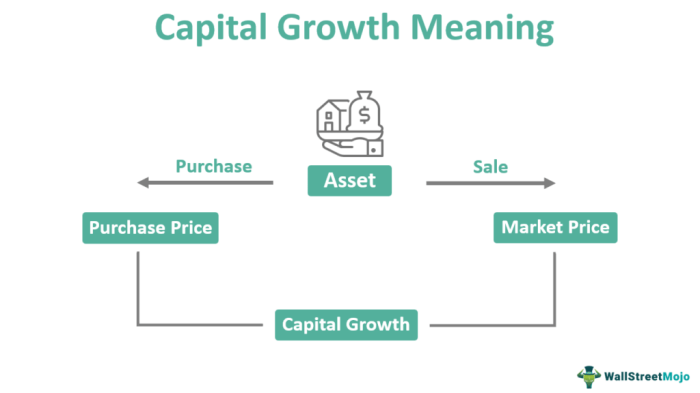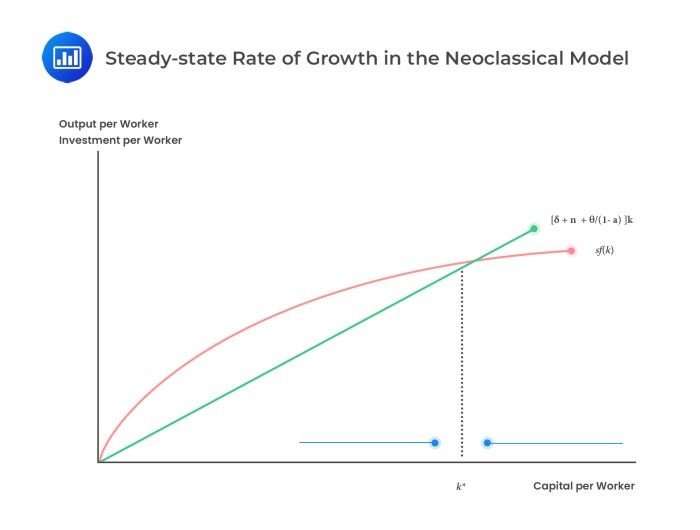
Embark on a journey through the world of Capital Growth Rate, exploring how it impacts investments and financial decisions.
Learn about calculating capital growth rate, key factors influencing it, and strategies for maximizing growth.
Capital Growth Rate
Capital growth rate refers to the increase in the value of an investment over time. It is a crucial metric for investors to assess the potential returns on their investments.
Calculation of Capital Growth Rate
To calculate the capital growth rate of an investment, you can use the following formula:
Capital Growth Rate = ((Ending Value – Beginning Value) / Beginning Value) x 100
This formula helps investors determine how much their investment has grown or appreciated over a specific period.
Impact of Capital Growth Rate on Investments
- Higher capital growth rates indicate better returns on investments, leading to increased wealth for investors.
- Investors can use the capital growth rate to evaluate the performance of their investment portfolio and make informed decisions.
- A low capital growth rate may signal stagnant or declining investment value, prompting investors to reassess their investment strategies.
Considering Risk in Evaluating Capital Growth Rate
It is essential for investors to consider the level of risk associated with an investment when evaluating the capital growth rate. A high capital growth rate may come with higher volatility and risk, while a lower rate could indicate a more stable but slower-growing investment.
Factors Influencing Capital Growth Rate
When it comes to understanding capital growth rate, there are several key factors that play a significant role in determining how investments will perform over time.
Economic Conditions
Economic conditions have a profound impact on the capital growth rate of investments. During times of economic growth, when there is low unemployment, high consumer spending, and stable interest rates, investments tend to perform well and experience higher capital growth rates. On the other hand, during economic downturns, such as recessions or depressions, investments may struggle to grow, leading to lower capital growth rates.
Industry Trends
The industry in which an investment operates can heavily influence its capital growth rate. Industries that are experiencing rapid growth, innovation, and high demand are likely to see higher capital growth rates compared to industries that are declining or facing regulatory challenges. Keeping an eye on industry trends and positioning investments accordingly can help maximize capital growth potential.
Inflation Rates
Inflation rates can also impact the capital growth rate of investments. When inflation is high, the purchasing power of money decreases, leading to lower real returns on investments. As a result, investors may see a decrease in capital growth rates during periods of high inflation. It is important to consider inflation rates when assessing the overall performance and potential growth of investments.
Strategies for Maximizing Capital Growth

Investing wisely is crucial for maximizing capital growth rate. Various strategies can help investors achieve their financial goals effectively.
Compounding and its Impact
Compounding is a powerful concept in investing that can significantly boost capital growth over time. By reinvesting earnings, you earn returns not just on your initial investment but also on the accumulated interest or dividends. This snowball effect can lead to exponential growth in capital.
Diversification for Enhanced Growth
Diversification is key to reducing risk and enhancing capital growth. By spreading investments across different asset classes, industries, and geographic regions, investors can mitigate losses from any single investment and increase the potential for long-term growth.
Time Horizon and Capital Growth Rate
The time horizon plays a crucial role in determining the capital growth rate. Investing for the long term allows investors to ride out market fluctuations and benefit from compounding over an extended period. Short-term investments may offer quick gains but are often riskier and less likely to generate substantial capital growth.
Capital Allocation

Capital allocation is the process of distributing an investor’s funds among different asset classes to achieve a balance between risk and return. It plays a crucial role in investment decisions as it determines the overall performance and diversification of a portfolio.
Process of Allocating Capital Across Different Asset Classes
- Determine investment goals and risk tolerance: Before allocating capital, investors need to identify their financial objectives and assess how much risk they are willing to take.
- Asset allocation strategy: Based on their goals and risk tolerance, investors can choose an asset allocation strategy that includes a mix of stocks, bonds, real estate, and other investments.
- Rebalancing: Regularly review and adjust the allocation of capital to maintain the desired asset mix and risk level.
Impact of Capital Allocation on Portfolio Performance
Effective capital allocation can help investors achieve diversification, reduce risk, and enhance returns. By spreading capital across various asset classes, investors can mitigate the impact of market fluctuations on their overall portfolio performance.
Examples of Effective Capital Allocation Strategies
- Modern Portfolio Theory: This strategy involves diversifying capital across different asset classes to optimize returns while minimizing risk.
- Strategic Asset Allocation: Investors set target allocations for various asset classes and periodically rebalance their portfolios to maintain those targets.
- Tactical Asset Allocation: This approach involves adjusting capital allocation based on short-term market conditions and opportunities.
In conclusion, understanding Capital Growth Rate is essential for making informed investment choices and achieving financial goals.
Question Bank
What is the importance of considering risk when evaluating capital growth rate?
Considering risk is crucial as it helps investors assess the potential downside of an investment and make informed decisions.
How do economic conditions influence capital growth rate?
Economic conditions such as interest rates and GDP growth can impact investor sentiment and ultimately influence capital growth rates.
What is the concept of compounding and how does it affect capital growth rate?
Compounding refers to the ability of an asset to generate earnings, which are then reinvested to generate additional earnings, thus accelerating capital growth rate over time.





